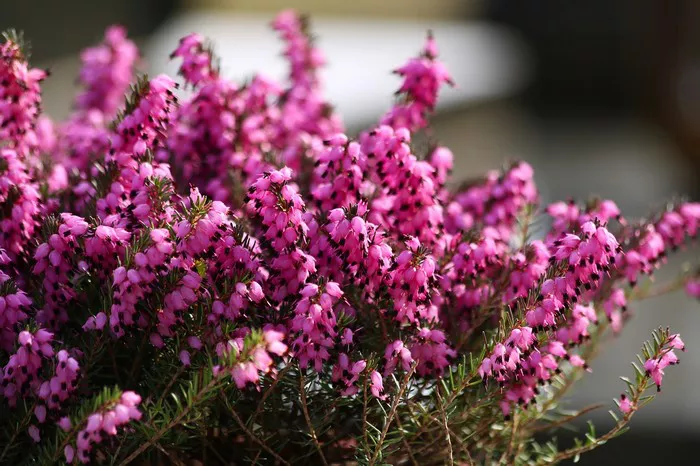Heather flowers, with their delicate beauty and vibrant colors, have captured the hearts of many gardeners and flower enthusiasts around the world. These charming blooms, belonging to the genus Calluna, are not only visually stunning but also hold significant cultural and ecological importance. In this comprehensive guide, we delve into the anatomy, variations, significance, and cultivating practices of heather flowers, offering insights into their captivating allure and how to cultivate them successfully.
Anatomy of Heather Flowers
Heather flowers boast a distinctive anatomy that contributes to their unique appearance and appeal. At first glance, these blooms may appear simple, but a closer look reveals intricate details that add to their charm.
1. Floral Structure: Heather flowers typically consist of small, bell-shaped blossoms clustered together in dense spikes atop slender stems. Each individual flower comprises a tubular corolla with four petals fused at the base, forming a narrow tube that flares out into a delicate, often reflexed lobed margin. These petals come in an array of colors, ranging from shades of pink, purple, and white to vibrant hues of red and magenta.
2. Foliage: Beyond their blossoms, heather plants are characterized by their needle-like foliage, which is arranged in dense, evergreen clusters along woody stems. The leaves are typically small, narrow, and scale-like, providing an elegant backdrop to the profusion of blooms.
3. Root System: Below the surface, heather plants develop a shallow, fibrous root system that spreads laterally, enabling them to thrive in a variety of soil conditions, including poor, acidic soils common in their native habitats.
Variations in Heather Flowers
Heather flowers exhibit remarkable diversity, with numerous cultivars and varieties available to suit various preferences and growing conditions. From subtle differences in flower color to variations in growth habit and foliage texture, there is a heather plant to complement any garden setting.
1. Flower Color: One of the most striking aspects of heather flowers is their wide range of colors. While shades of pink and purple are most common, cultivars with white, red, magenta, and even bi-colored blooms can be found. Some varieties also feature foliage that changes color throughout the seasons, adding further interest to the landscape.
2. Growth Habit: Heather plants exhibit diverse growth habits, ranging from low-growing ground covers to upright shrubs. Compact varieties such as Calluna vulgaris ‘Beoley Gold’ form neat mounds of foliage adorned with abundant blooms, making them ideal for edging pathways or rock gardens. In contrast, taller cultivars like Calluna vulgaris ‘Dark Beauty’ can reach heights of up to two feet, creating striking focal points in garden borders.
3. Foliage Texture: While most heather plants feature fine-textured, needle-like foliage, there are exceptions. Some cultivars, such as Calluna vulgaris ‘Velvet Fascination,’ boast softer, more velvety leaves that add a tactile element to the garden. These variations in foliage texture can be used to create contrast and visual interest when designing with heather plants.
Significance of Heather Flowers
Beyond their aesthetic appeal, heather flowers hold cultural significance and play essential roles in various ecosystems. From ancient folklore to modern-day gardening practices, these blooms have left an indelible mark on human society and the natural world.
1. Cultural Symbolism: Throughout history, heather flowers have been revered for their beauty and symbolism. In Celtic folklore, heather was associated with good luck, protection, and spiritual healing, leading to its inclusion in rituals and ceremonies. In Scottish tradition, heather played a prominent role in wedding customs, symbolizing love, passion, and resilience.
2. Ecological Importance: In addition to their cultural significance, heather plants provide vital habitat and food sources for a wide range of wildlife. Bees, butterflies, and other pollinators are drawn to the nectar-rich blossoms, helping to support healthy ecosystems and promote biodiversity. The dense foliage of heather plants also offers shelter and nesting sites for small mammals and birds, further enhancing their ecological value.
Cultivating Heather Flowers
Successfully cultivating heather flowers requires careful attention to their specific growing requirements, including soil, sunlight, water, and maintenance practices. By following these guidelines, gardeners can enjoy a bountiful display of blooms year after year.
1. Soil Conditions: Heather plants thrive in acidic, well-draining soils with a pH level between 4.5 and 6.0. To create optimal growing conditions, amend heavy or alkaline soils with organic matter such as peat moss or compost and avoid planting in areas prone to waterlogging.
2. Sunlight: Heather flowers prefer full sun to partial shade, although some varieties can tolerate dappled shade in hot climates. To promote healthy growth and abundant blooms, provide at least six hours of direct sunlight per day, ensuring adequate air circulation around the plants.
3. Watering: While heather plants are drought-tolerant once established, they require consistent moisture during the establishment period. Water newly planted specimens regularly, keeping the soil evenly moist but not waterlogged. Once established, reduce watering frequency, allowing the soil to dry out slightly between waterings to prevent root rot.
4. Pruning and Maintenance: Proper pruning is essential for maintaining the health and appearance of heather plants. In late spring or early summer, trim back spent flowers and leggy growth to promote bushier, more compact growth. Avoid cutting into old wood, as this can inhibit future blooming. Additionally, apply a balanced fertilizer formulated for acid-loving plants in early spring to encourage vigorous growth and vibrant blooms.
Conclusion
Heather flowers enchant us with their exquisite beauty, intricate anatomy, and cultural significance. Whether adorning garden borders, rockeries, or containers, these charming blooms add color, texture, and charm to any landscape. By understanding their anatomy, exploring variations, appreciating their significance, and mastering cultivation techniques, gardeners can cultivate heather flowers successfully and enjoy their timeless allure for years to come.


